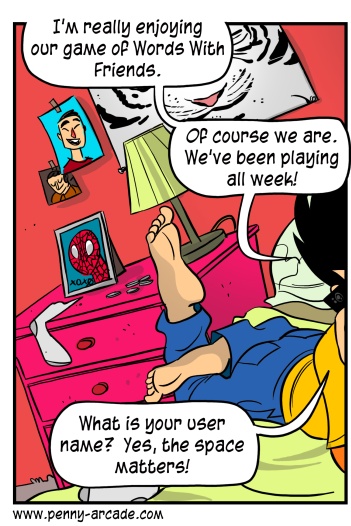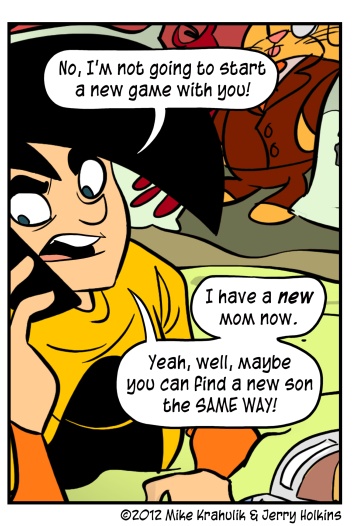It has become obvious by now that Moms crave games, they crave them; theirs is the hunger absolute. One of the games these ravenous moms crave is Words With Friends.
I once played Scrabble with a mother not my own and also with Brenna's Grandmother, which is a kind of meta-mom, and these two beat the shit out of me. People assume that I would be good at Scrabble because I collect words, but Scrabble isn't a game where you just recite all the words you know really fast. I would be a bull-headed death god at that game, which doesn't exist, unless you count Taboo.
No, these women took turns thrashing me with my own language until the bag ran mercifully out of tiles. I saw this mom again at Christmas - "Nancy" - and somewhere in her fully eight pages of iPhone apps I saw Words With Friends poking out, and thought I might have an opportunity for Redemption capital r. No, actually. I never even finished that game. I could see the ravine, and I jerked the wheel hard right.
Gabriel recently had an experience in this vein that was transformed into a comic, somehow. It has been more than thirteen years of constant production, and I'm not certain I'll ever fully recognize the process.
I'm obsessed with a game called Flash Duel, by Sirlin Games; I carry the deck around in my pocket just to think about it any spare moment, or to harangue others into playing a match.
David Sirlin is obsessed with something too, that being asymmetry in competitive games, to the extent that it might considered his "thing." I own every game he's ever produced for the table, and we have complimentary fetishes: he wants to codify personalities as game mechanics, and I think social interaction is itself a game.
If I explained how to play Flash Duel, it would sound like something you couldn't be obsessed with. It would seem reductive and dumb. So I can bring this all around with a food metaphor later, let's describe the basic engine, or "broth":
Players draw a hand of five cards from a twenty five card deck, which made up of cards numbered one through five. Two players start at opposite ends of an eighteen space track. Taking turns, they play the cards in their hand to
1. Move that number of spaces forward or backward
2. If Adjacent, Push the Opponent the number of spaces shown
3. Attack by playing a card equal to the number of spaces your opponent is away
4. Perform a Dashing Attack by playing a move card, then an attack card.
You can make an attack more powerful by playing multiples of the same card, and you can block by playing the same cards you were attacked with. There are a couple nuances - for example, Dashing Attacks can be retreated from with a Move card instead of blocking. There are only five cards of each number, and you can look through the discard, so the probabilities become more confined. If I hit you, I get a point, and we play to five points. It's fine. It's alright. Whatever.
Now let's add noodles. In the box, the game comes with twenty "characters" represented by three cards each, each of which put a certain spin on the game with their unique abrogations of the rules. I'm looking at a minotaur whose entire purpose is to back you up against your end of the track and deliver custom unblockable strikes. Let's call him "hoisin." Here's someone who can play fours as threes, and vice versa. Let's call her "thai basil." Here's a flame archer that can strike at extreme range; she'll be our Sriracha. It goes on like this. And on, and on. You can put into it what you like.
There are seven game modes: a handful of 1v1s, tag teams, and even co-op modes in the vein of the World of Warcraft TCG's Raid Decks. It's these individually simple mechanisms squaring off against one another in a legible, friendly system of quick resolution that keeps it at the front of my thoughts. I like to play games, certainly, but I like learning them better, and a game I will be able learn over and over again is the best kind.
(CW)TB out.



